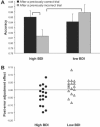Resting anterior cingulate activity and abnormal responses to errors in subjects with elevated depressive symptoms: a 128-channel EEG study
- PMID: 16035102
- PMCID: PMC6871316
- DOI: 10.1002/hbm.20172
Resting anterior cingulate activity and abnormal responses to errors in subjects with elevated depressive symptoms: a 128-channel EEG study
Abstract
Depression has been associated with dysfunctional executive functions and abnormal activity within the anterior cingulate cortex (ACC), a region critically involved in action regulation. Prior research invites the possibility that executive deficits in depression may arise from abnormal responses to negative feedback or errors, but the underlying neural substrates remain unknown. We hypothesized that abnormal reactions to error would be associated with dysfunctional rostral ACC activity, a region previously implicated in error detection and evaluation of the emotional significance of events. To test this hypothesis, subjects with low and high Beck Depression Inventory (BDI) scores performed an Eriksen Flanker task. To assess whether tonic activity within the rostral ACC predicted post-error adjustments, 128-channel resting EEG data were collected before the task and analyzed with low-resolution electromagnetic tomography (LORETA) using a region-of-interest approach. High BDI subjects were uniquely characterized by significantly lower accuracy after incorrect than correct trials. Mirroring the behavioral findings, high BDI subjects had significantly reduced pretask gamma (36.5-44 Hz) current density within the affective (rostral; BA24, BA25, BA32) but not cognitive (dorsal; BA24', BA32') ACC subdivision. For low, but not high, BDI subjects pretask gamma within the affective ACC subdivision predicted post-error adjustments even after controlling for activity within the cognitive ACC subdivision. Abnormal responses to errors may thus arise due to lower activity within regions subserving affective and/or motivational responses to salient cues. Because rostral ACC regions have been implicated in treatment response in depression, our findings provide initial insight into putative mechanisms fostering treatment response.
Copyright 2005 Wiley-Liss, Inc.
Figures




Similar articles
-
Spatiotemporal dynamics of error processing dysfunctions in major depressive disorder.Arch Gen Psychiatry. 2008 Feb;65(2):179-88. doi: 10.1001/archgenpsychiatry.2007.19. Arch Gen Psychiatry. 2008. PMID: 18250256 Free PMC article.
-
Neural responses to negative feedback are related to negative emotionality in healthy adults.Soc Cogn Affect Neurosci. 2012 Oct;7(7):794-803. doi: 10.1093/scan/nsr054. Epub 2011 Sep 14. Soc Cogn Affect Neurosci. 2012. PMID: 21917847 Free PMC article.
-
Executive function and error detection: The effect of motivation on cingulate and ventral striatum activity.Hum Brain Mapp. 2010 Mar;31(3):458-69. doi: 10.1002/hbm.20879. Hum Brain Mapp. 2010. PMID: 19718655 Free PMC article.
-
Emotional processing in anterior cingulate and medial prefrontal cortex.Trends Cogn Sci. 2011 Feb;15(2):85-93. doi: 10.1016/j.tics.2010.11.004. Epub 2010 Dec 16. Trends Cogn Sci. 2011. PMID: 21167765 Free PMC article. Review.
-
Contributions of anterior cingulate cortex to behaviour.Brain. 1995 Feb;118 ( Pt 1):279-306. doi: 10.1093/brain/118.1.279. Brain. 1995. PMID: 7895011 Review.
Cited by
-
Concurrent electrophysiological recording and cognitive testing in a rodent touchscreen environment.Sci Rep. 2021 Jun 3;11(1):11665. doi: 10.1038/s41598-021-91091-9. Sci Rep. 2021. PMID: 34083596 Free PMC article.
-
Adolescent peer interaction and trait surgency weaken medial prefrontal cortex responses to failure.Soc Cogn Affect Neurosci. 2012 Jan;7(1):115-24. doi: 10.1093/scan/nsq090. Epub 2011 Jan 5. Soc Cogn Affect Neurosci. 2012. PMID: 21208989 Free PMC article.
-
Explicit and implicit emotion regulation: a dual-process framework.Cogn Emot. 2011 Apr;25(3):400-12. doi: 10.1080/02699931.2010.544160. Cogn Emot. 2011. PMID: 21432682 Free PMC article. Review.
-
Increased error-related brain activity distinguishes generalized anxiety disorder with and without comorbid major depressive disorder.J Abnorm Psychol. 2012 Nov;121(4):885-96. doi: 10.1037/a0028270. Epub 2012 May 7. J Abnorm Psychol. 2012. PMID: 22564180 Free PMC article.
-
Gamma oscillations as a biomarker for major depression: an emerging topic.Transl Psychiatry. 2018 Sep 4;8(1):177. doi: 10.1038/s41398-018-0239-y. Transl Psychiatry. 2018. PMID: 30181587 Free PMC article. Review.
References
-
- Abela JRZ, D'Alessandro DU (2002): Beck's cognitive theory of depression: a test of diathesis‐stress and casual mediation components. Br J Clin Psychol 41: 111–128. - PubMed
-
- Ary JP, Klein SA, Fender DH (1981): Location of sources of evoked scalp potentials: corrections for skull and scalp thicknesses. IEEE Trans Biomed Eng 28: 447–452. - PubMed
-
- Asada H, Fukuda Y, Tsunoda S, Yamaguchi M, Tonoike M (1999): Frontal midline theta rhythms reflect alternative activation of prefrontal cortex and anterior cingulate cortex in humans. Neurosci Lett 274: 29–32. - PubMed
-
- Auer DP, Putz B, Kraft E, Lipinski B, Schill J, Holsboer F (2000): Reduced glutamate in the anterior cingulate cortex in depression: an in vivo proton magnetic resonance spectroscopy study. Biol Psychiatry 47: 305–313. - PubMed
-
- Austin MP, Mitchell P, Goodwin GM (2001): Cognitive deficits in depression: possible implications for functional neuropathology. Br J Psychiatry 178: 200–206. - PubMed
Publication types
MeSH terms
Grants and funding
LinkOut - more resources
Full Text Sources
Other Literature Sources

